Welcome to the world of open shelving, where elegance meets functionality in the most delightful way! Whether you’re just starting your journey into interior design or you’re a seasoned decorator, “14 Elegant Open Shelving Design Ideas” is your ticket to transforming any room with style and sophistication. With this guide, you’ll discover how to use open shelving to express your personality and create a space that’s both beautiful and organized.
Open shelving is more than just a trend—it’s an opportunity to showcase your creativity while maximizing space. This curated list offers innovative ideas that will not only enhance the aesthetic appeal of your home but also bring practical benefits such as improved accessibility and easy maintenance. By embracing these techniques, you’ll gain the confidence to revamp your space with flair, turning everyday living areas into stunning displays of design excellence.
Highlight with Strategic Lighting
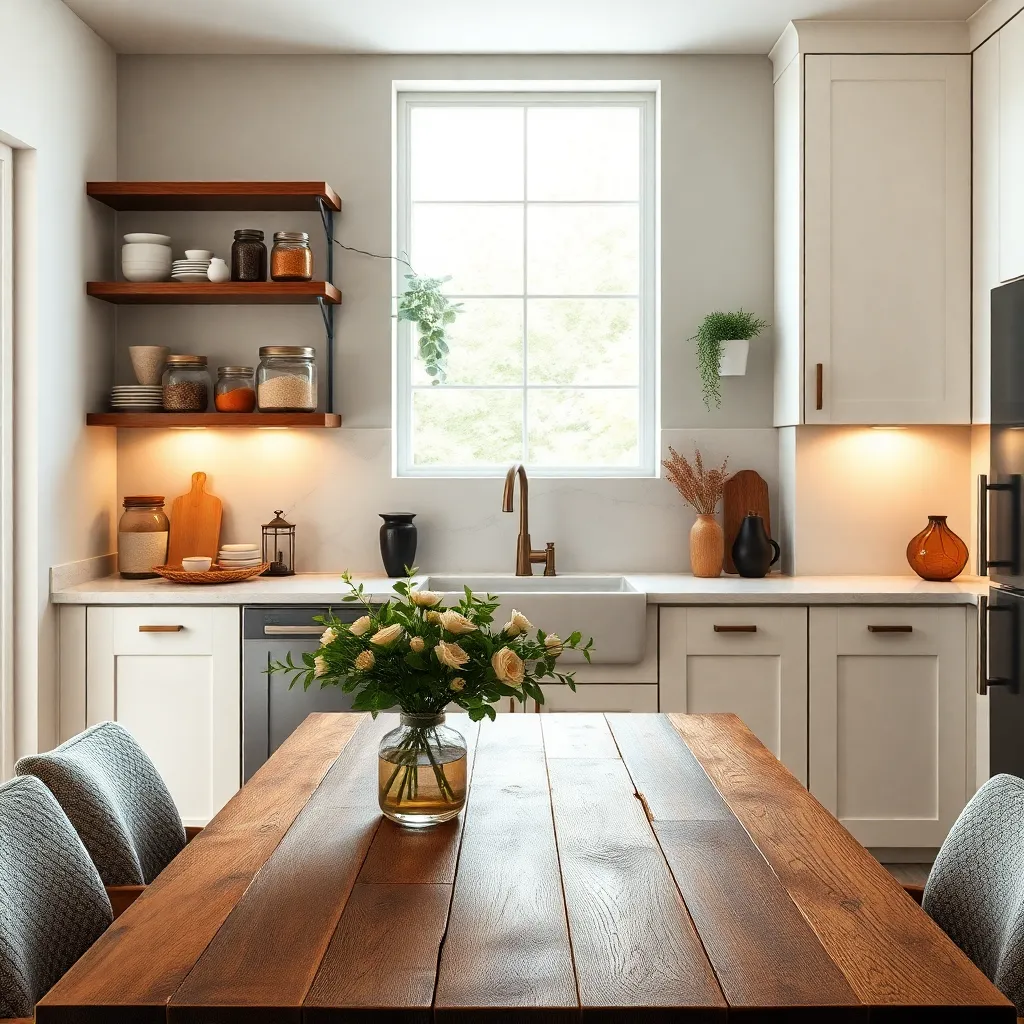
To create a visually captivating open shelving display, consider incorporating strategic lighting to highlight your favorite pieces. LED strip lights installed underneath each shelf can provide a warm, inviting glow that emphasizes both the beauty of the objects and the architecture of the shelving.
For a more dynamic look, consider using adjustable spotlights that can be directed towards specific items on your shelves. These can be particularly effective for showcasing artwork or decorative pieces, ensuring they become focal points in the room.
Another option is to use recessed lighting within the shelves themselves. This not only adds an elegant touch but also ensures even lighting distribution, making it easier to highlight intricate details of your displayed items.
To create an ambient atmosphere, incorporate dimmers that allow you to adjust the intensity of your lighting based on the time of day or mood you wish to set. This flexibility ensures that your shelving display remains a stunning feature, whether you’re hosting a dinner party or enjoying a quiet evening at home.
Mix Materials for Visual Interest
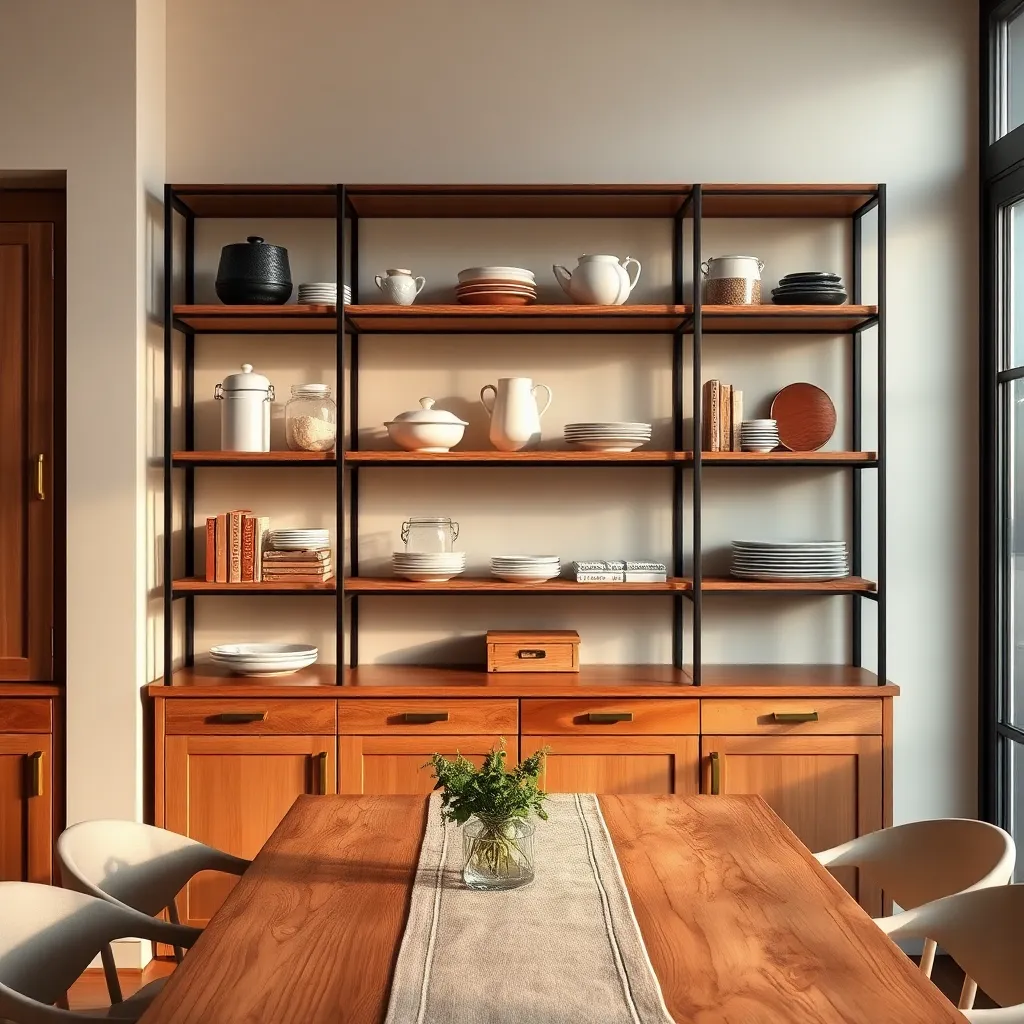
Mixing materials in open shelving can create a dynamic and visually engaging display. Consider combining materials like wood, metal, and glass to add depth and texture to your shelves.
Begin by selecting a sturdy wood like oak or walnut for the shelves themselves, which provides a warm and inviting foundation. Complement these with metal brackets or supports, offering a modern touch and ensuring your shelving is both stylish and secure.
Incorporate glass elements such as small decorative bowls or vases to introduce transparency and lightness. This not only helps to break up the solidity of the wood and metal but also reflects light, enhancing the room’s brightness.
For advanced decorators, experiment with more intricate combinations, such as using reclaimed wood for a rustic look paired with polished brass for contrast. This approach can be particularly effective in transitional spaces where you want to maintain a balance between traditional and contemporary styles.
Incorporate Plants for Freshness
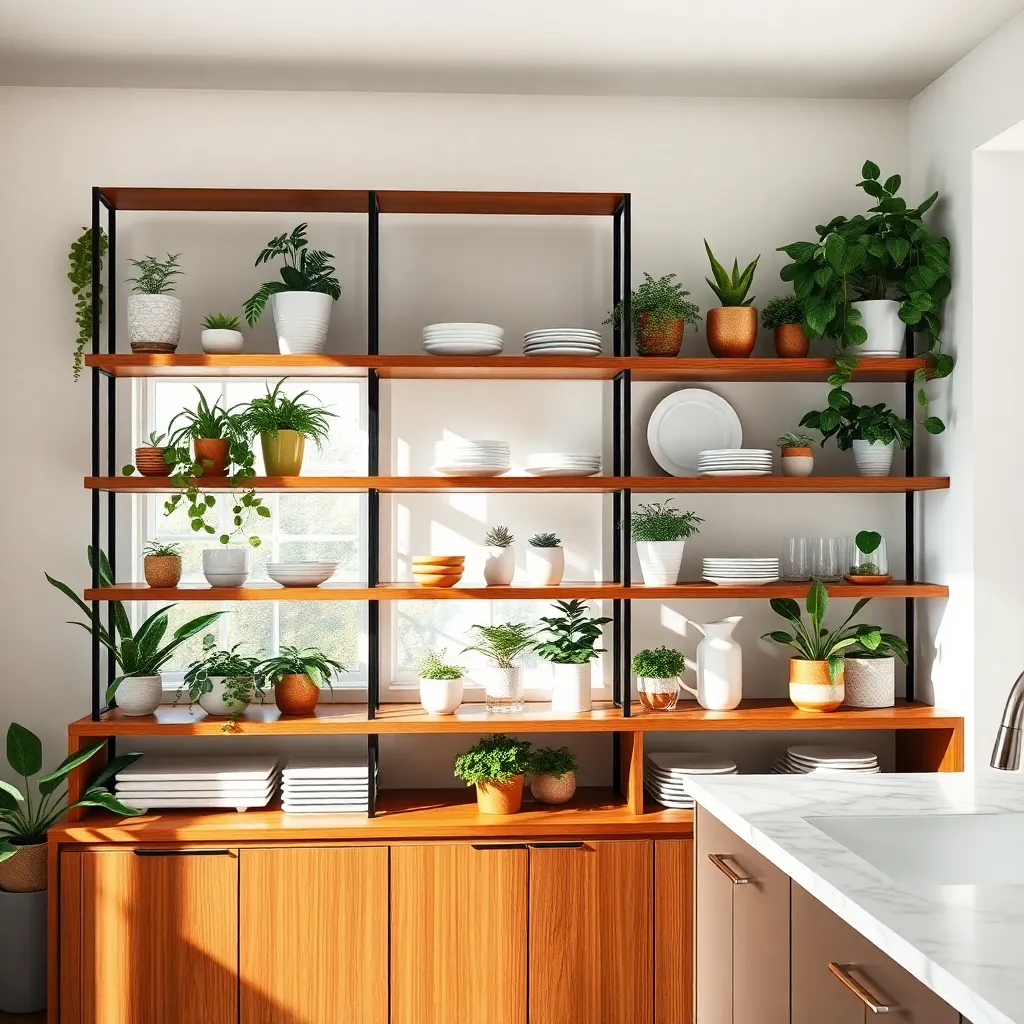
Adding plants to your open shelving is an excellent way to infuse a sense of freshness and vitality into your space. Consider opting for easy-to-care-for plants like pothos or succulents, which thrive in a variety of lighting conditions and require minimal maintenance.
For a cohesive look, select planters that complement your existing decor style. Neutral-toned ceramic pots can blend seamlessly into most designs, while bold, colorful planters can serve as eye-catching focal points.
Placement is key when incorporating plants into your shelving. Position taller plants on the top shelf to draw the eye upwards, while smaller, trailing varieties can be placed on lower shelves to create a cascading effect.
To add depth and interest, mix different plant textures and heights within your arrangement. By alternating between leafy greens and spiky succulents, you’ll create a dynamic display that captivates attention and enhances the room’s aesthetic.
Arrange Books by Color
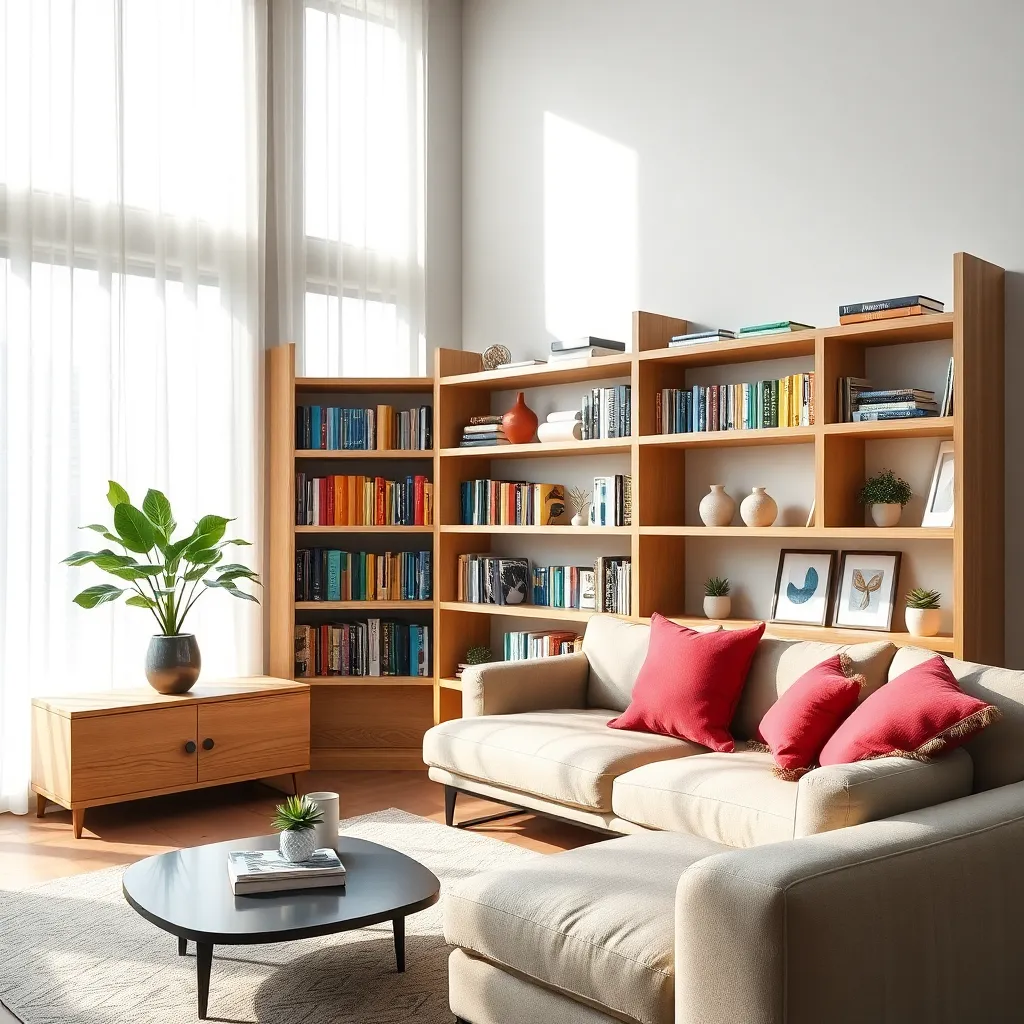
Transform your shelves into a visual delight by arranging books by color. This simple yet effective method creates a stunning gradient effect that can elevate the entire room.
Begin by sorting your books into piles based on their cover colors. This will help you visualize how the colors transition from one to another, creating a seamless flow.
When arranging the books, consider starting with darker shades at either end and moving towards lighter hues in the center. This technique draws the eye and adds depth to your shelves.
To enhance the visual appeal, mix in decorative elements like vases or small sculptures that complement your chosen color scheme. These accessories can act as focal points, breaking up the monotony and adding texture to your display.
Use Decorative Storage Baskets
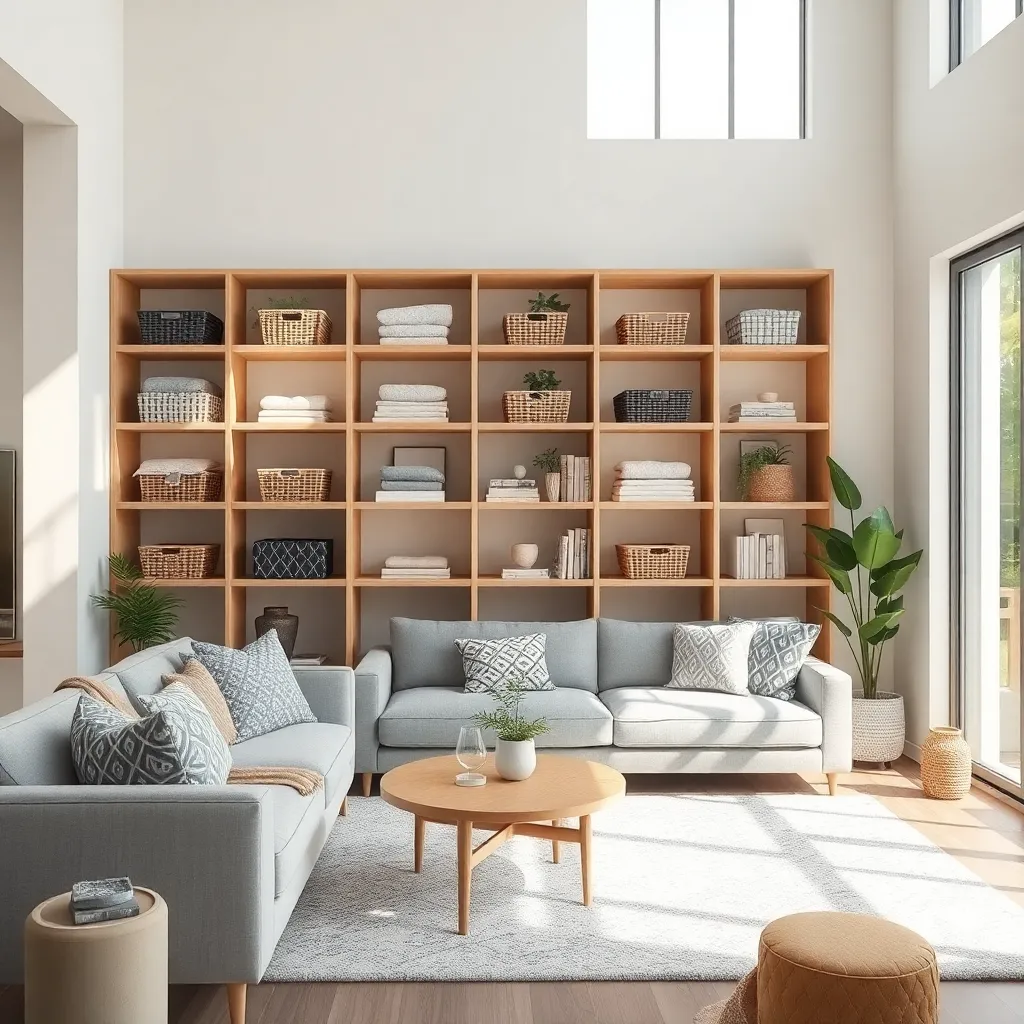
Decorative storage baskets are an elegant solution for organizing open shelves while adding texture and warmth to your space. Opt for baskets made from natural materials like woven seagrass or rattan for a cozy, earthy touch that complements most decor styles.
Strategically place these baskets on lower shelves to easily store items such as blankets, magazines, or toys while maintaining a tidy appearance. For a more sophisticated look, choose baskets in varying sizes and shapes to create visual interest and depth.
Incorporating baskets in neutral tones like beige, ivory, or gray can seamlessly blend with your existing color scheme. If you’re feeling adventurous, choose baskets with subtle patterns or pops of color to add a playful element to your shelving design.
For a cohesive style, match the basket handles or trims with other elements in the room, such as drawer pulls or lamp bases. This attention to detail will give your open shelving an intentional and polished look, making it not only functional but also a beautiful focal point in your home.
Display Art Pieces Sparingly
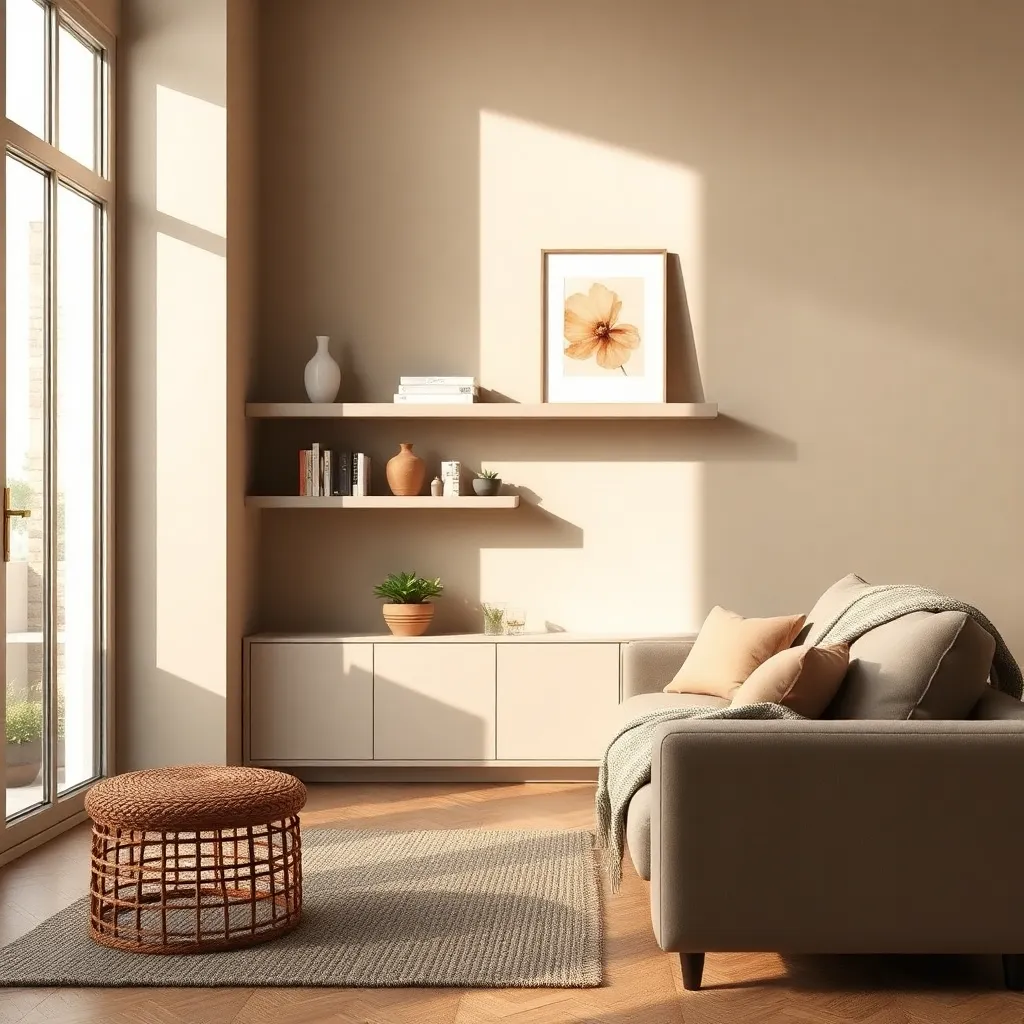
When incorporating art pieces into your open shelving, it’s crucial to practice restraint to avoid overwhelming the space. Displaying art sparingly allows each piece to shine, drawing attention without creating visual clutter. Consider the size and scale of the art relative to the shelves. Smaller artworks can be grouped with other decorative elements, while a larger piece might stand alone to serve as a focal point.
Balance is key when arranging art on open shelves. Start by selecting a few key pieces that complement your room’s color scheme and style. Neutral tones and simple frames are versatile and work well with various decor themes, from minimalist to traditional. For those with a more eclectic taste, mix textures and materials, such as pairing a smooth ceramic vase with a rustic wooden sculpture.
Placement is just as important as the art itself. Position art pieces at eye level or slightly above to ensure they are easily noticeable and appreciated. If your shelves are part of a larger wall unit, intersperse art with books and decorative objects to create an engaging visual rhythm. Remember, a cohesive look is achieved not just through the individual pieces, but through their interaction with surrounding elements.
For a curated look, experiment with layering art pieces. Place smaller items in front of larger pieces to add depth and interest. Use complementary colors and themes to tie the display together, ensuring that the art enhances rather than distracts from the overall aesthetic of the room. By thoughtfully selecting and arranging your art, you can create a stylish and personalized display that elevates your open shelving.
Add Personal Touches with Photos
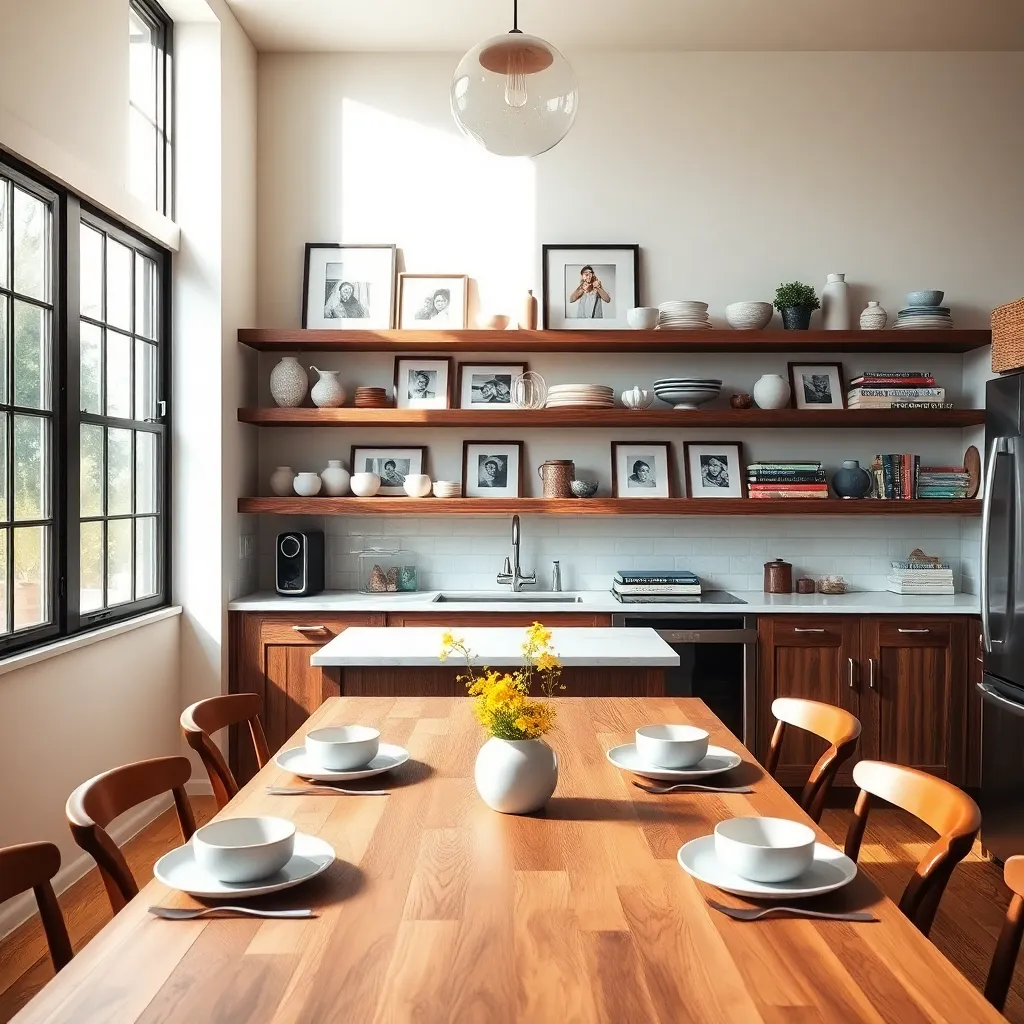
Infusing your shelves with personal touches can significantly enhance the warmth and character of your home. Photos are a wonderful way to add a personal dimension to your open shelving while telling your own story. Consider using a mix of frame sizes to create visual interest. A combination of small, medium, and large frames can add depth to your display without overwhelming the space.
To make your photos truly stand out, select frames that complement your existing decor. Wooden frames provide a rustic touch, while metallic frames can add a hint of modern elegance. Arrange them in a slight arc or staggered pattern to break linear monotony, ensuring a more dynamic display. This approach allows each photo to catch the eye without competing for attention.
For a cohesive look, consider using a limited color palette that ties in with your room’s decor. Black and white photos offer a classic, timeless appeal and can blend seamlessly with a variety of design styles. For those seeking a bolder statement, choose vibrant frames or colorful prints that resonate with the room’s accent colors. This technique can help highlight specific areas of your shelving, drawing the eye naturally to your cherished memories.
Advanced decorators can experiment by layering photos with other decor elements like small sculptures or vases. This layered approach not only enhances the visual interest but also adds a sense of depth and texture to the space. Keep the shelves balanced by varying the height and orientation of the frames and objects. Such thoughtful arrangements ensure that your shelving remains both functional and visually appealing.
Balance Symmetry and Asymmetry
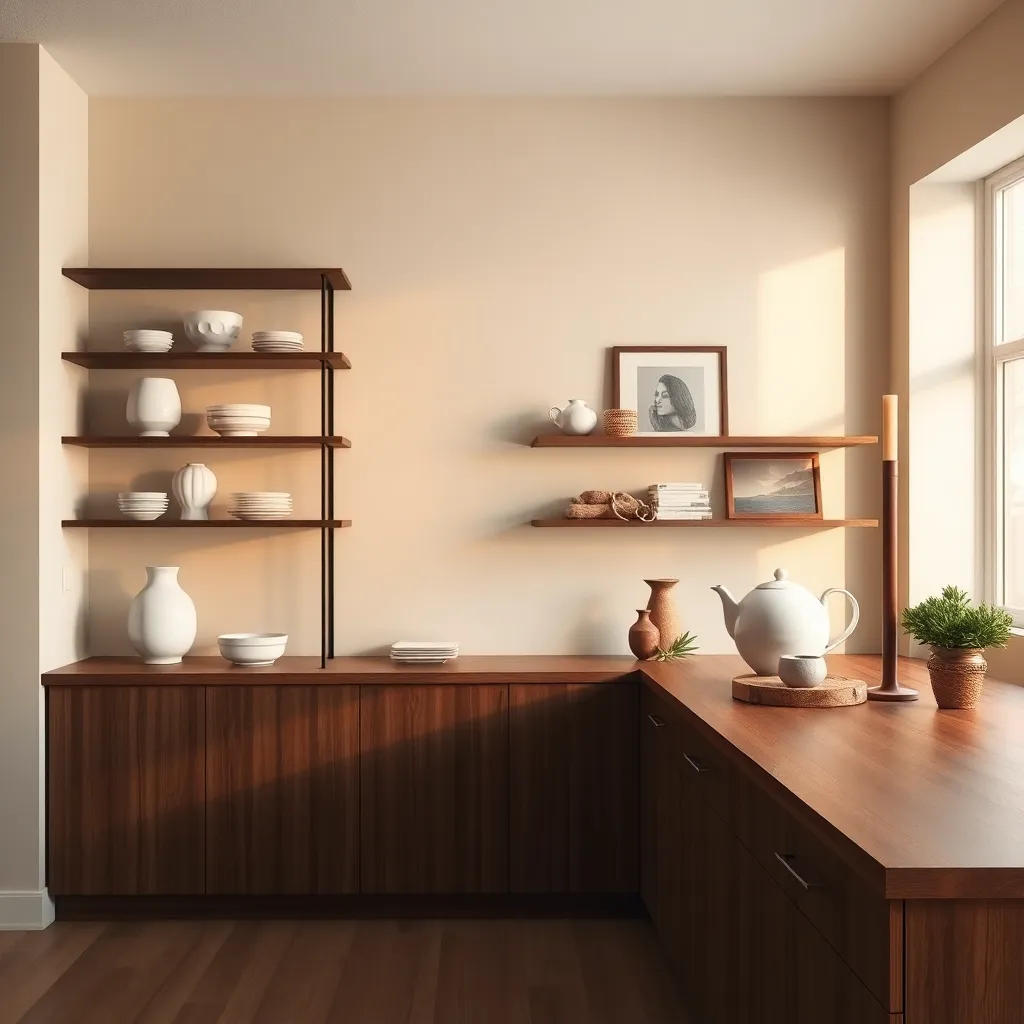
Creating a visually appealing open shelving setup involves skillfully balancing symmetry and asymmetry. Symmetry can lend a sense of order and calm, ideal for showcasing pairs of items such as vases or books. However, incorporating asymmetry can add visual interest and dynamic energy to the space. To achieve this, try offsetting a large item with a cluster of smaller ones, introducing a playful visual tension.
When selecting items for symmetrical arrangements, choose pieces that are similar in size and shape but vary in color or texture for depth. Consider placing matching baskets or storage boxes on either end of a shelf to create a balanced look. On the other hand, for an asymmetrical arrangement, mix objects of various heights and shapes to draw the eye across the display. This could involve placing a tall sculpture next to a low stack of books, creating a sense of movement.
For beginners, start by using a simple color palette to tie together both symmetrical and asymmetrical elements. Consider using a trio of colors, such as white, gray, and a pop of teal, to maintain cohesion without overwhelming the senses. Advanced decorators might experiment with contrasting textures like smooth ceramics against rough wood, enhancing the tactile experience.
Remember, negative space is just as crucial in creating balance as the objects themselves. Leaving some shelves partially empty prevents the arrangement from feeling cluttered and gives each piece room to breathe. Be mindful of the overall harmony as you mix and match, ensuring that no single item overpowers the others, maintaining a cohesive yet dynamic display.
Layer Textures for Depth
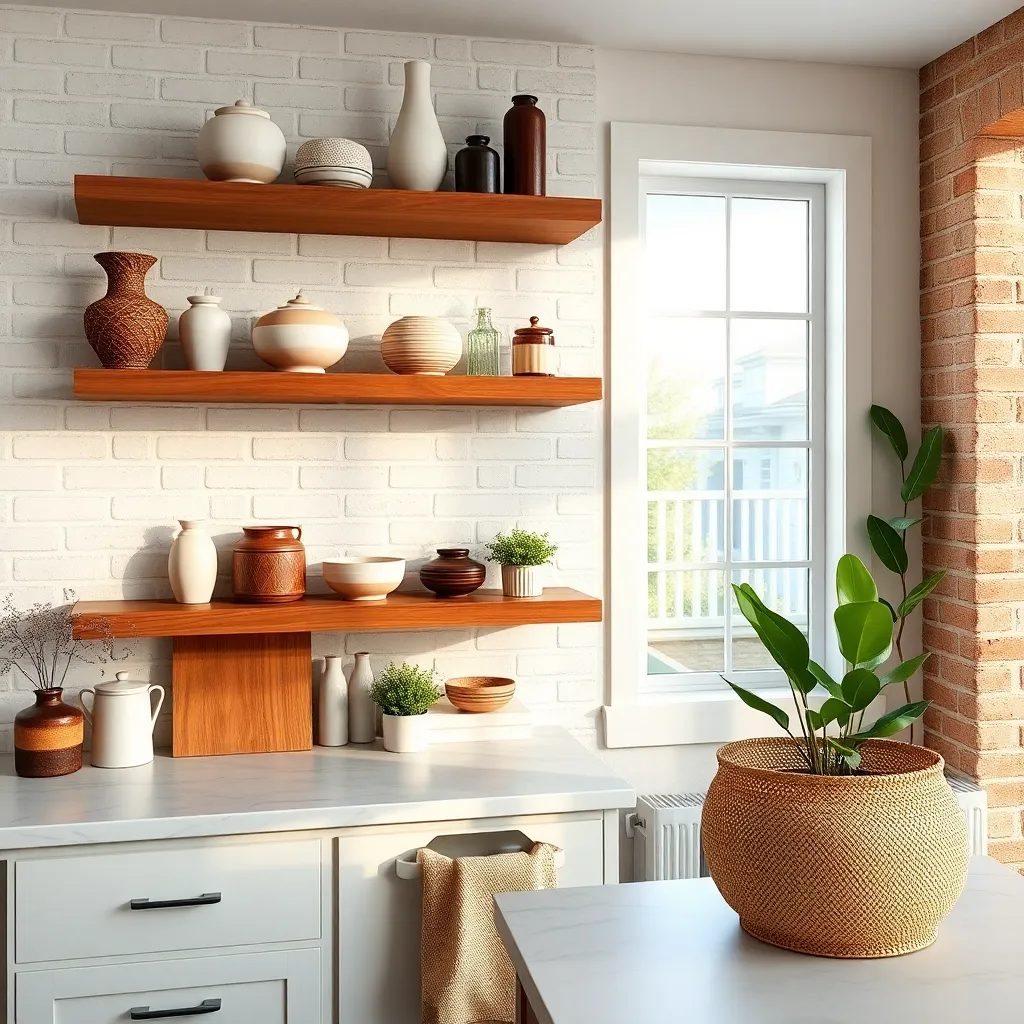
To create depth and interest on open shelving, start by layering textures through various decor items. Mix materials like wood, metal, and glass to add dimension and visual intrigue to your shelves.
Consider incorporating textiles such as woven baskets or fabric-covered boxes for added warmth. These elements not only provide storage but also introduce a tactile quality that enhances the overall look.
For beginners, start with simple combinations like pairing smooth ceramics with rough-hewn wooden pieces. This basic contrast is effective in adding complexity without overwhelming the space.
For a more advanced approach, intertwine luxury materials like marble or brass with soft, natural fibers like linen or jute. This sophisticated blend elevates the aesthetic while maintaining a balanced harmony across your shelves.
Curate a Minimalist Aesthetic
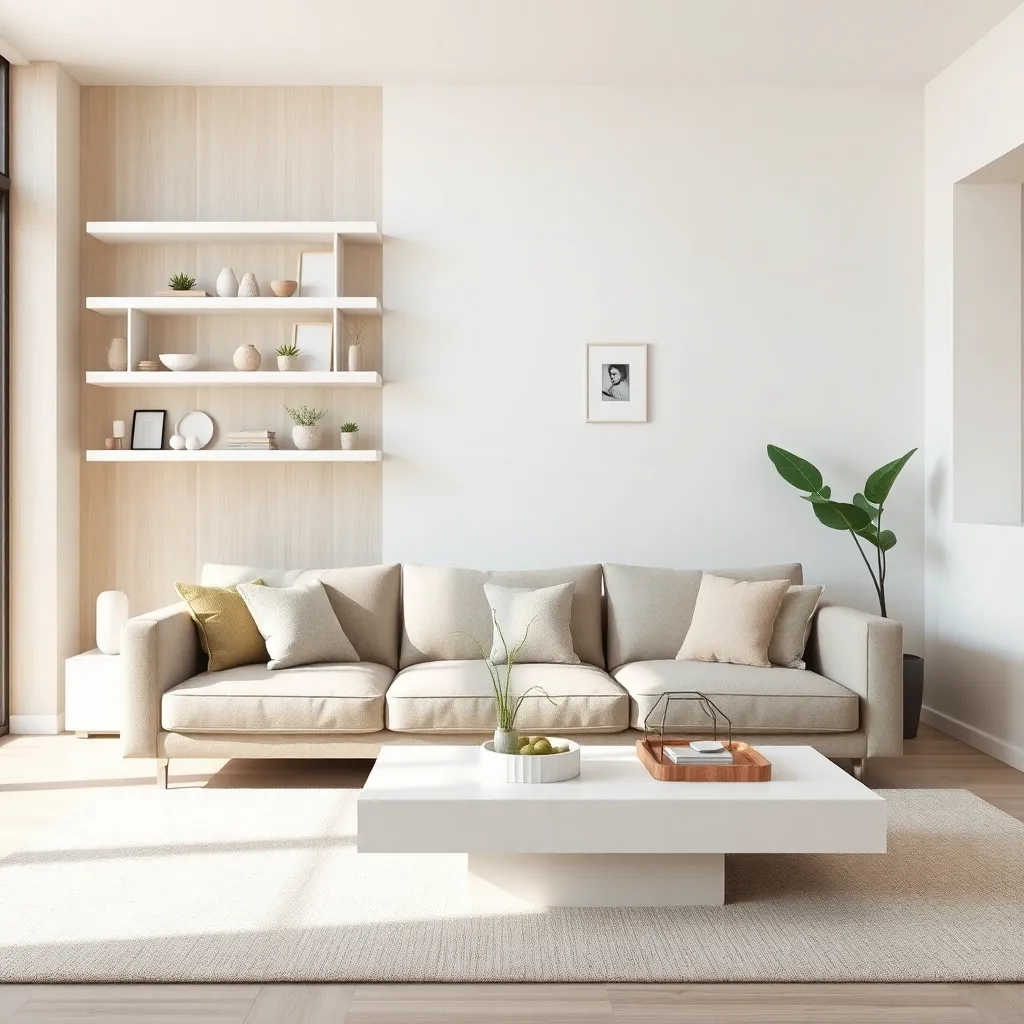
Embrace the essence of minimalism by focusing on quality over quantity when selecting items for your open shelves. Choose pieces that are functional and beautiful, such as a sleek vase or a modern clock, to create a space that feels both curated and uncluttered.
Consider a neutral color palette to maintain a serene and cohesive look across your shelving. Whites, greys, and muted earth tones can create a calming backdrop, allowing a few carefully chosen accent pieces to stand out without overwhelming the space.
To add interest without clutter, use negative space strategically on your shelves. This means leaving certain areas intentionally empty, which can enhance the visual appeal and make each item feel more significant.
For those looking to take their minimalist design to the next level, consider incorporating natural materials such as wood, stone, or glass. These elements add texture and warmth while maintaining a clean and simple aesthetic, perfectly aligning with minimalist principles.
Feature Seasonal Decor Rotations
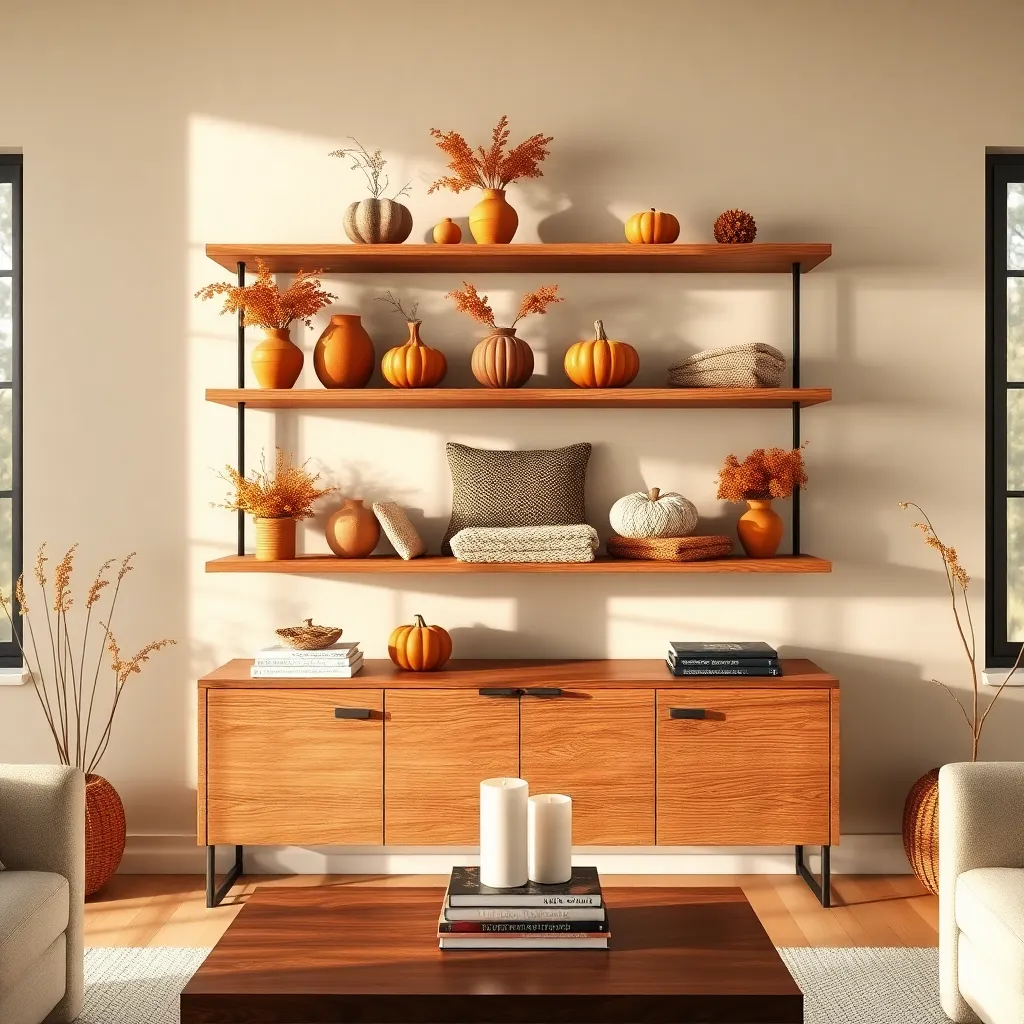
Integrating seasonal decor rotations into your open shelving is a fantastic way to keep your space fresh and engaging. Begin by selecting a neutral base for your shelves, such as white or natural wood, which will allow seasonal pieces to stand out without overwhelming the room.
For spring, consider adding vibrant touches with pastel-colored vases or small potted plants. These can be easily swapped out for earthy tones and textured fabrics like burlap or woven baskets as the fall approaches, bringing warmth and coziness to your space.
Incorporate small, easily interchangeable items like framed seasonal artwork or decorative plates to reflect the current season. Ensure these items are lightweight and easy to swap, allowing for a seamless transition between seasons without requiring a complete overhaul.
Advanced decorators might consider layering textures like wool and silk during winter to create depth and a luxurious feel. Pairing these materials with metallic accents in gold or silver can further enhance the festive atmosphere during the holiday season.
Utilize Clear Acrylic Shelves
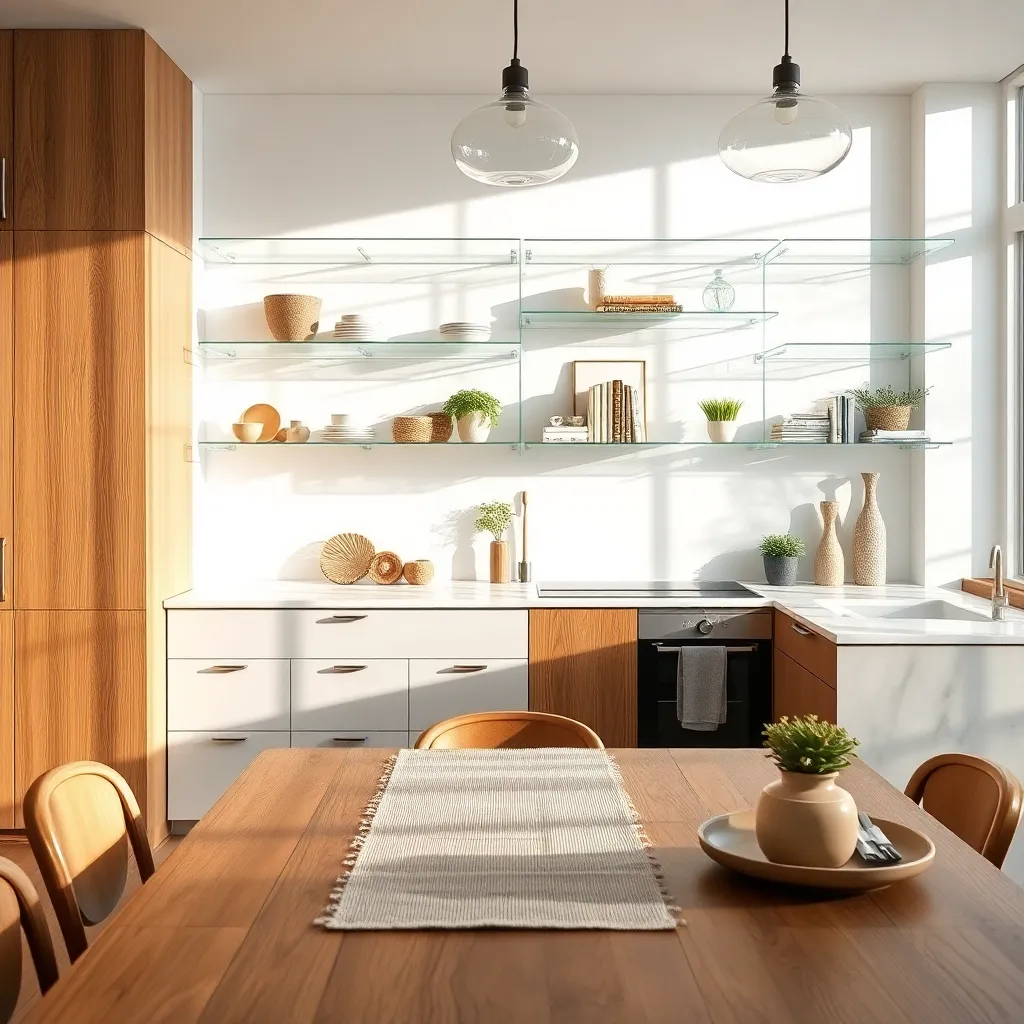
Clear acrylic shelves bring a modern and minimalist touch to any room, making them an ideal choice for those who want to showcase their decor without overwhelming the space. Their transparent nature allows them to blend seamlessly with any color scheme, making them a versatile option for both bold and neutral color palettes.
To maximize visual impact, consider placing clear acrylic shelves in areas with ample natural light, which will enhance their almost invisible appearance and keep the space feeling open. When arranging items on these shelves, balance is key; mix decorative objects of varying heights and textures to create an engaging display.
An excellent way to use acrylic shelves is in small spaces where traditional shelving might feel too bulky. They can be installed in kitchens to keep spices and small utensils easily accessible or in bathrooms to store toiletries while maintaining an uncluttered look. For a more advanced approach, use them to display a rotating art collection, allowing the walls behind to be part of the visual story.
When installing acrylic shelves, ensure they are securely anchored to support the weight of your chosen decor pieces. If you’re a beginner, start with lightweight items like vases or small sculptures, while more experienced decorators can experiment with heavier pieces by ensuring the shelves are properly supported. This approach allows for both a practical and aesthetic solution, enhancing your interior design with elegance and functionality.
Opt for Floating Shelf Designs
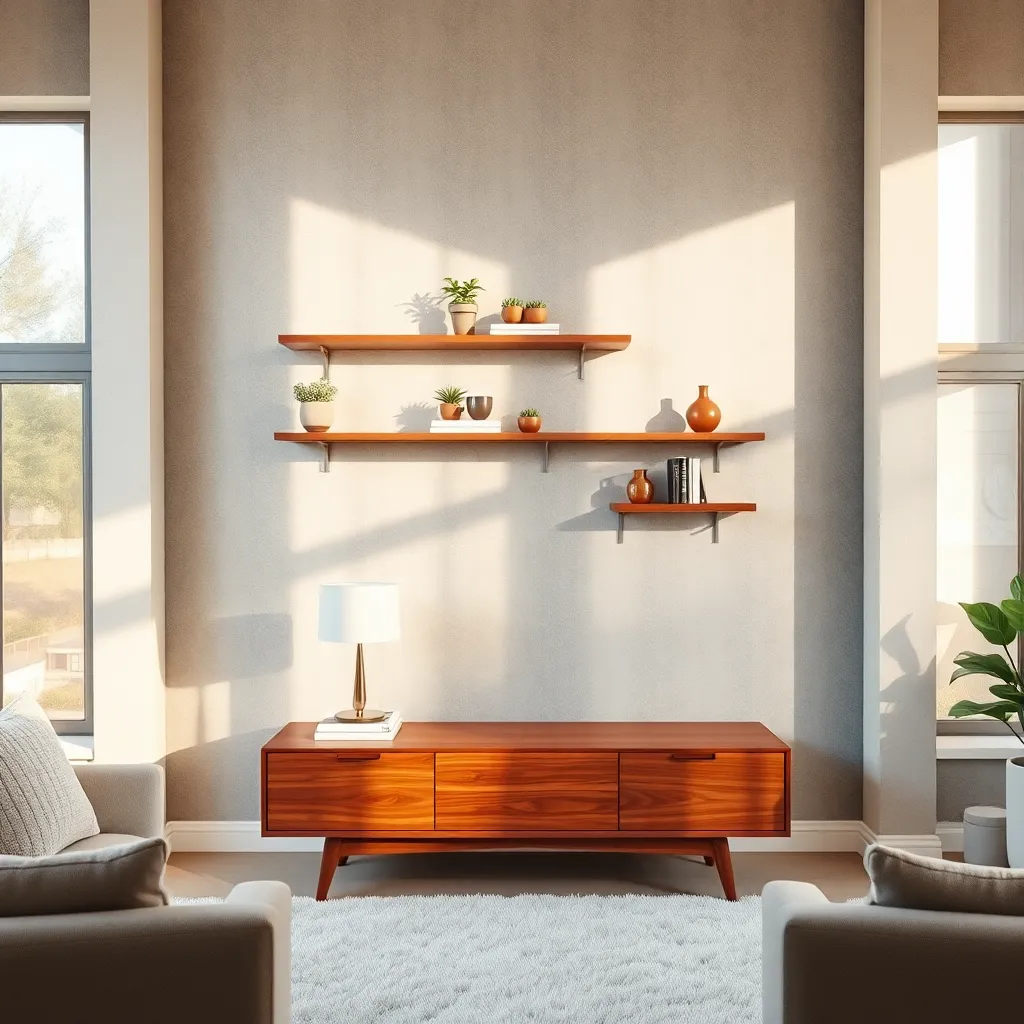
Floating shelves are a versatile choice that can enhance the aesthetic of any room while maximizing space. Consider using natural wood materials for a warm, organic look, or opt for sleek metal designs to fit a modern decor style.
Place floating shelves in the kitchen to display beautiful dishware or cookbooks, adding both function and elegance. Ensure they are securely mounted by following the manufacturer’s instructions, using appropriate brackets or anchors for added stability.
To create a cohesive look, coordinate the color of your shelves with existing furniture or wall colors. For a bold statement, choose contrasting colors that stand out, drawing attention to your curated displays.
Advanced decorators might layer multiple floating shelves of varying lengths to create visual interest and depth. This approach not only increases storage but also allows for dynamic arrangements of decor items like plants, art pieces, or collectibles.
Integrate Shelving with Wall Color
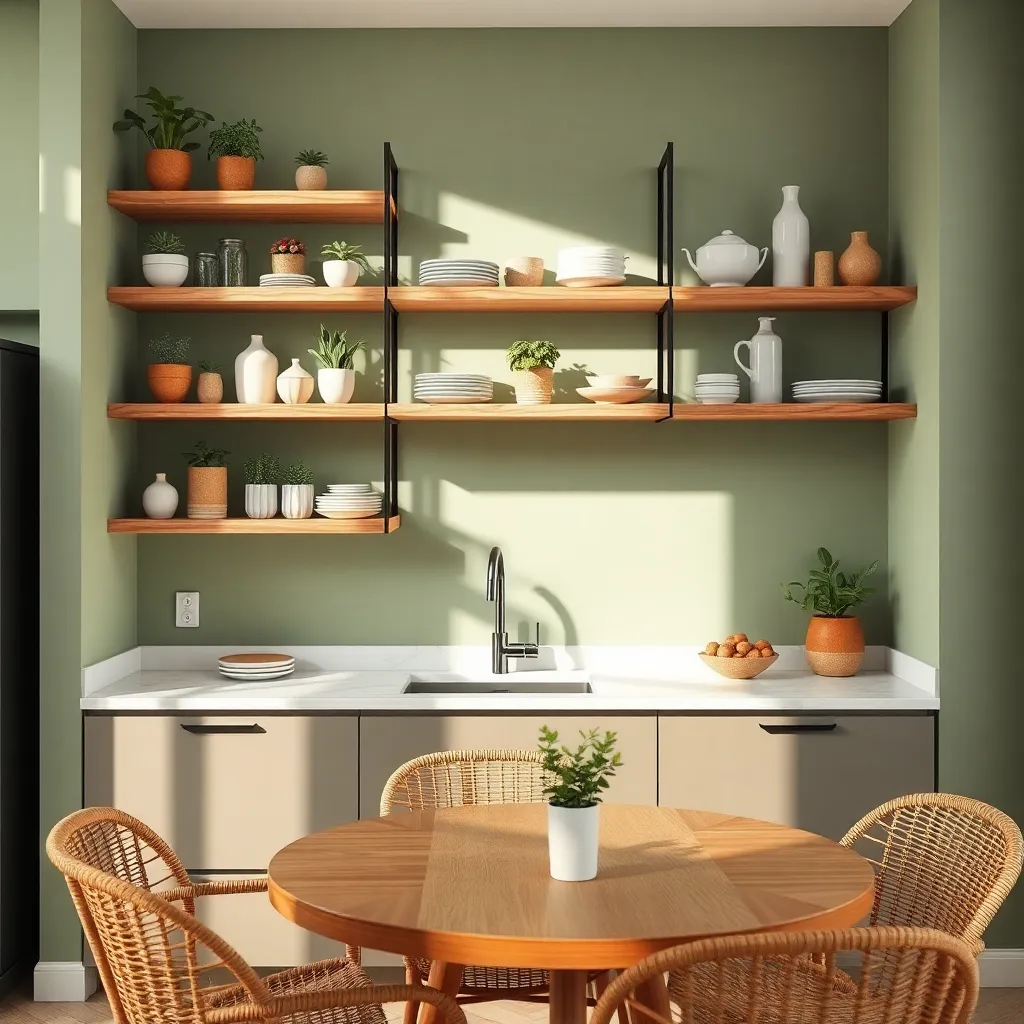
Integrating shelving with your wall color can create a seamless and elegant look that enhances the overall aesthetic of your room. To achieve this, consider painting your shelves the same color as your walls for a cohesive effect that allows items on the shelves to stand out.
Matching the wall and shelf color can make a space feel larger and more unified, especially in small rooms. This technique works particularly well with neutral tones like whites, greys, and beiges, which provide a sophisticated backdrop for your decor.
For those looking to add a touch of creativity, try using a slightly darker or lighter shade of your wall color for the shelves. This subtle contrast can add depth and dimension while maintaining harmony within the space.
Advanced decorators might experiment with textured or matte finishes on shelves to add an additional layer of interest without overwhelming the design. Choose materials like wood or metal that can be easily painted and paired with a variety of wall colors to suit your personal style.
Conclusion: Growing Success with These Plants
In exploring the 14 elegant open shelving design ideas, we’ve discovered that relationships, much like well-organized spaces, thrive on creativity, balance, and thoughtful arrangements. We discussed the importance of transparency, adaptability, and support, much like shelves that must be both functional and aesthetically pleasing. Each design idea served as a metaphor for nurturing relationships—whether it’s through embracing minimalism to focus on what truly matters or using layered textures to add depth and richness to your connections.
As an actionable step, identify one relationship in your life that could benefit from a little reorganization or enhancement. Whether it’s adding a touch of gratitude, fostering open communication, or simply spending more quality time together, take that step today.
Remember, relationships are living entities that can blossom with the right care and attention. Bookmark this article to remind yourself of these elegant ideas that can be applied to your personal connections. As you move forward, know that with intentional effort and creativity, your relationships can not only endure but flourish beautifully. Here’s to cultivating bonds that are as stunning and resilient as the most elegantly designed spaces.
